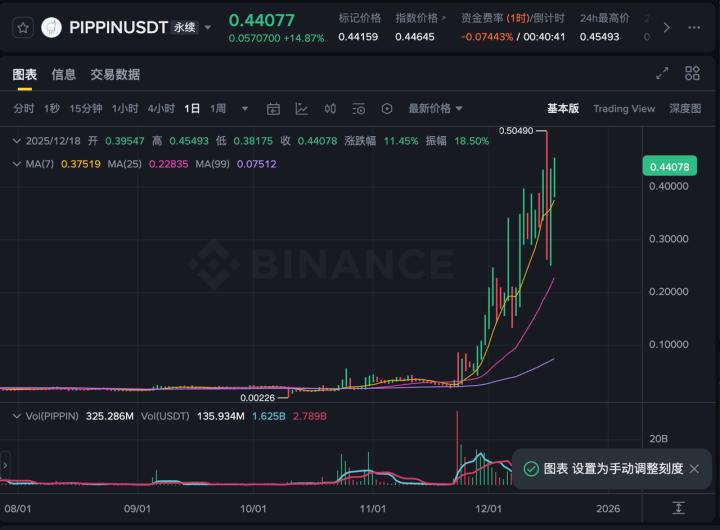Here is the English translation of the text, with the specified terms translated as instructed:
The current crypto market has retreated from its frenzy, and the volatility has been exacerbated by the narrative dominated by retail investors, but the market adjustment may create opportunities for long-term investment and new narratives.
Written by: Michael Dempsey
Compiled by: Bai Hua Blockchain
Nowadays, the crypto market is in an interesting stage. It has been only 8-12 weeks since the peak of market frenzy, but news keeps coming that the governments, which were once the most complained about by the crypto market, are now choosing to embrace this asset class and its technology. However, despite this, the market has fallen into a gloomy mood that I haven't seen in a long time.
The joke "developers, do something" now seems powerless, because the "developers" have already taken action, choosing to free the market and remove many restrictions and attacks on the crypto field. Therefore, the future of this industry now, to be honest, depends entirely on us.
So, what happened? No one can be sure, but these are some of my thoughts this morning.
1. Macro Level
I don't intend to review the crypto market performance in the past few months in detail, but I want to say that it is quite interesting to see the market psychology constantly changing and becoming more moderate between our president and the factors affecting the market.
In 2024, many people made money in the so-called "Trump trade", specifically by betting that the market was underestimating the possibility of Trump's victory and the resulting policy changes. However, it now appears that the Trump trade was over-bought, both at the overall mid-term market level and in the short-term crypto market. Trump's election (and the following weeks) may have been a typical "buy the rumor, sell the news" event, as BTC skyrocketed from around $70,000 to $106,000 after his victory, and the market then entered an adjustment phase. Just like many cases in the crypto market, the entire market has once again run ahead of reality.
I won't dwell too much on the market's performance here, but I suggest you follow Smac and read his recent articles on volatility and the like. From a medium-term perspective, I may be slightly more bearish than Smac, but he's probably smarter than me, so I recommend you check out his views.
Now, let's talk about something not entirely about prices.
2. Stop Outsourcing Market Narratives to Retail Investors
This may sound a bit strange, but I think the crypto market has largely outsourced speculation and narrative building to the smallest participants (individual investors) and those on the riskiest part of the risk curve. This has led to a chain reaction, where the speculators who may not be mature enough and are easily deceived have become the ones leading the market narrative, and these narratives often spread in the crypto echo chamber (Crypto Twitter, trader group chats, the divide between Western and Asian markets, etc.) before institutions get involved. And some institutions' own investment analysis methods are no different from retail investors, which further exacerbates this phenomenon.
These narratives have driven large market price fluctuations and absorbed a lot of capital, especially in the absence of new market participants entering. Capital rotation is almost calculated by the week, with Tokens experiencing crazy rallies and then crashing by more than 80%. This market dynamic cannot support long-term investment, nor can it attract new capital inflows into the crypto market (except for BTC), let alone drive long-term industry building.
I believe what is truly needed is for projects to think more proactively about how to position their products in the crypto space. In other words, projects should take the initiative to create new narratives, rather than passively cater to existing narratives.
Some may think the only important thing in the crypto market is "gambling" - switching to a new Token in the hope of making more money. But even within this framework, different narratives can be built around this core logic.
Usually, the largest projects (L1 and L2) will follow certain market narratives, hoping to drive long-term development through short-term TVL growth. However, the problem is that the adjustment speed of large projects is much slower than small projects, so when they finally turn to a certain narrative, that narrative has often already died. We've recently seen the example of the AI narrative, where TAO captured most of the value in the early stage and successfully shaped that narrative, while the subsequent "GPT wrapper" small projects actually weakened the influence of this narrative.
We've also seen similar situations in other "X + crypto" concepts, such as:
- NFT (art + crypto)
- Investment DAOs (investment funds + crypto)
- RWA (traditional finance + crypto)
- OHM (fool + crypto)
Recently, we've seen the rise of Memecoins on a larger scale ("cultural" speculation + crypto, or narrative meta-game + crypto). In the future, we will likely continue to witness similar cycles.
All crypto projects ultimately hope to build a core user base (what we often call a "community") that is ideologically and economically aligned with the project. Based on this, if you are building a project, your goal should be to build a "propaganda agency" that can spread the narrative in the early stage. As an organization, a foundation, or a small group with far more resources and influence than retail investors (after all, you have already issued tokens or raised funds), your task is to create a narrative that you truly believe in, and to promote to the market why this narrative is important and why your project can lead it. Rather than trying to get a piece of an existing narrative that already has market awareness. Competing is a game for losers, and competing for existing narratives is particularly difficult.
Bet on the future you believe in, and become the "Schelling Point Protocol" of that future.
3. Power Law & Compounders
As an investor involved in areas ranging from venture capital to the crypto market to the public stock market, I find that the consensus in different markets varies greatly. Many people like to compare the public market with the crypto market, but there is a core misconception that actually reveals the problem with today's crypto market - which is also why some people (or perhaps only me) feel disappointed.
Over the past 5 to 15 years, public market investors have gradually "discovered" the concept of long-term compounding ROI at the company level, where large companies often become much bigger than anyone expected, and the value they accumulate far exceeds market perception. These companies usually have multiple characteristics, such as the ability to fully leverage technological waves, and a broad vision from the very beginning. This investment logic means that investing in companies that can grow steadily in the long run with relatively controllable drawdowns is a better choice than investing in those that may experience violent fluctuations, potentially skyrocketing but also crashing by more than 80%.
In the public market, this trend has made it more difficult for hedge funds to survive. The "Mag7" (Microsoft, Apple, Google, Amazon, Meta, Tesla, Nvidia) and some other companies with compounding growth characteristics have created huge upward momentum in the core indices, making it difficult for hedge funds to outperform the market without taking on higher risks. As a result, many fund managers have started to shift to a concentrated long-term holding strategy, often allocating a certain percentage to Mag7 stocks, while claiming to achieve relatively small drawdowns in the 2022 bear market (but the reality is that many fund managers still invested in speculative tech stocks and were eventually eliminated by the market).
1) The Dilemma of Compounding Growth in the Crypto Market
Crypto hedge funds also face similar challenges, especially with BTC. BTC (in my view) has an extremely high risk/reward ratio and encompasses multiple core narratives such as "new currency", "inflation-resistant asset", and "crypto market index". BTC often becomes the benchmark index for all liquid crypto asset strategies. Similar to public market hedge funds, many crypto hedge funds perform well during market upswings, but they essentially rely on leveraged long strategies, leading to severe drawdowns when the market declines, with their performance far below BTC in risk-off years, ultimately underperforming the market benchmark in the long run.
In the crypto market, there have been almost no "compounding growth" assets in the true sense, except for L1 public chains like ETH and SOL. This is because infrastructure-type projects are more likely to achieve long-term growth through horizontal expansion. However, some teams are now trying to break this limitation, but a pending question is: can the existing Token economic model support this goal? Or, to truly build a project with compounding growth characteristics, should one start a company from scratch rather than issuing a Token too early? (This may also be an important reason why project teams should not issue Tokens too early.)
2) The Future of Compounding Growth Projects
We have many thoughts on this, but in any case, we believe this market dynamic will change in the crypto realm. Some founders are starting to view their projects as potential compounding growth assets and have a broader strategic vision than in past market cycles. This shift is expected to bring more rationality to the crypto market and establish a core benchmark. Currently, the crypto market lacks a set of assets with good risk-adjusted returns, forcing market participants to choose highly speculative shitcoins and frequent capital rotation. If genuine compounding growth projects emerge, the market investment logic may change accordingly.
4. Conclusion
As BTC and the entire market slowly declined from around $95,000 to $80,000, I reflected on how to build lasting value in the crypto realm, an idealized and even utopian view that carries a touch of irony. This round of market correction is one of the most orderly sell-offs I've seen recently. However, when you witness the entire industry retreating from "belief", I believe this is an opportunity to establish a new investment framework, shape a new narrative, and establish a unique fundamental perspective in the "ruins" left after the market has washed out low-conviction investors.







